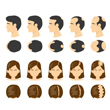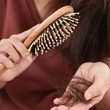Reasons For Hair Loss in Men Under 25
Hair loss at 20 in males is the common scenario seen these days. The reason for this premature hair loss is somehow attributed to genetics. If an individual has a family history of baldness, he experiences the same hair loss pattern at one point in his life or the other. Apart from genetics, other factors like lifestyle, hormonal imbalance, and illness can also engender hair loss in younger men. Scroll down to know the reasons for hair loss in men under 25 in great detail and also how to treat the condition.
Six Reasons for Hair Loss in Men under 25 2,3,4,5,6
Premature hair loss can occur due to various reasons, and some of them include:

1. Nutrition
Alopecia or hair loss can result from nutritional deficiencies, especially that of protein, iron, and zinc. Men who deprive themselves of nutrition to reach weight loss goals or those who rely on fad diets can develop such deficiencies. To treat them, it’s wise to eat foods rich in vitamins and minerals necessary for optimal hair health. You can also rely on hair supplements, but make sure not to overdose your body with these nutrients as it can lead to adverse side effects.
2. Autoimmune Disorders
Certain autoimmune disorders are another reason behind hair loss at 20 in males. For instance, alopecia areata is a kind of autoimmune disorder that damages hair follicles.
3. Hormones
Male pattern baldness or androgenetic alopecia is a type of genetic hair loss that is common in males. This hair loss occurs when dihydrotestosterone, aka DHT, derived from the male sex hormone testosterone, attacks the hair follicles.
As per scientific theories, DHT results in abrupt hair growth cycles. Since younger men are more sensitive to DHT, they tend to experience premature hair fall or male pattern baldness.
4. Stress
Stress is often linked to hair loss. Any stressful situation in life, such as struggling to get a job, losing a family member, or recovering from illness, can negatively impact hair health.

5. Use of Certain Medications
Hair loss in younger men can also be a possible side effect of certain medications. Medications like antidepressants, high blood pressure drugs, antibiotics, and anticlotting drugs can lead to hair loss. So, it’s crucial to talk to a doctor before taking any medication.
6. Medical Conditions
Temporary hair loss that occurs in men at an early age can also be a result of medical issues like thyroid, anemia, diabetes, cancer, etc. Conditions like cancer call for chemotherapy which leads to hair fall.
How to Treat Hair Loss in Your 20s
When it happens at an early age, hair loss or alopecia can be a sign of a medical problem that needs to be treated. Here are a few well-known treatments doctors suggest for early hair loss:
1. Medications
Although there is no cure for genetic hair loss or male-pattern baldness, a few medications can slow down the rate of hair loss. Medications like minoxidil and finasteride are popular treatments for male pattern baldness. Both these medications can be taken after a dermatologist’s prescription. They need to be adhered to consistently for visible results.
2. Lifestyle Changes
Making positive lifestyle changes can treat certain kinds of hair loss in young men. Apart from eating a nutrient-rich diet, regular scalp massages can help. Also, practicing meditation to de-stress and avoid smoking can prove to be fruitful. Other lifestyle changes that can benefit greatly include:
- Regularly trimming hair to avoid split ends.
- Using only natural hair care products.
- Drying hair naturally and avoiding heat styling tools.
- Sleeping well at night.
- Keeping hydration levels in check.
3. Hair Transplant
Hair transplants are common treatments men adopt to cover their balding scalp. In such procedures, the surgeon will take healthy hair strands from the side and back of the head and shift the strands to bald regions.
4. Wigs and Hairpieces
Wearing wigs and hairpieces is a fail-proof way to cover the bald scalp. This is why many young men struggling with hair loss or receding hairline adopt this practice. The downside of wearing wigs is that they are expensive and need to be removed before bedtime.
Hair Loss Prevention Tips 10
Unless you are suffering from male pattern baldness or any other form of genetic hair loss, certain precautions can save you from losing hair in the first place.
- Manage your stress levels to overcome stress-related hair loss.
- Do frequent scalp massages, especially with essential oils, to boost hair growth.
- Pay attention to everyday diet and eat protein-rich foods along with those rich in zinc, iron, and biotin.
- Never comb wet hair as it can lead to hair breakage.
- Take hair supplements to provide nutrition to hair for optimal hair health.
Bottom Line
Premature hair loss can be stressful. Luckily, it can be stopped unless it is genetic. And if you have male pattern baldness, it’s wise to consult a good dermatologist who can give you the proper treatment to curb your genetic hair loss.
Myth Busters HairFall

Androgenetic Alopecia - Everything You Need To Know
Have you been experiencing excessive hair fall over a prolonged period of time? It could be an early sign of androgenetic alopecia. It is a hair loss disorder common in both genders and can lead to progressive thinning and even baldness in some patients if not caught and treated early.

How To Make Hair Grow Faster For Men
A head full of healthy hair is a matter of confidence. Hair has its own mechanism of growing and shedding, and it is when this mechanism is thrown off that growth is hindered. Especially in the case of males, hair growth faces a lot of hiccups that can easily be managed.

Female Pattern Baldness - Causes & Treatments
Have you suddenly noticed an increase in the number of hair strands on your pillow in the morning? Or is your ponytail getting thinner by day? Well, you might be suffering from female pattern baldness. While that does sound scary, identifying it early on is key to treating this condition effectively. So keep reading to know what this is, how you can identify it, and most importantly, what treatments you can avail of to get your beautiful lustrous hair back.

What Are The Reasons For Hairfall?
Almost everyone experiences some amount of hair thinning over the years. Shedding around 50 to 100 single strands of hair per day is considered normal. However, losing more than 150 strands a day, experiencing sudden thinning, or developing circular bald patches on your scalp are reasons for concern. Hair loss occurs when new hair doesn’t grow fast enough to replace the amount of hair you lose daily. Hair can fall due to various reasons, with hereditary hair loss and poor nutrition being the most common hair fall reasons.

Expert Approved Tips For Hair Growth
What can be more debilitating than seeing hundreds of hair strands shedding from your scalp every time you brush your hair? Also, excessive molting occurs during seasonal changes that can be very stressful for you. Although it’s okay to lose between 50-100 strands every day, according to the American Academy of Dermatology, the problem occurs when you start shedding more than normal. But that doesn’t mean you have to feel helpless as there are ways to grow your hair back. Even if you are coping with baldness or alopecia, certain hair growth tips from dermatologists can come to your rescue. Read on to discover how these tips can be your savior when abnormal hair fall problems are in sight.
Trending Videos
+ 10 Sources
'LMRC - GGI-CO-A2-DMA-300001252-300001252-WM-L21-704'
© 2021 Dr. Reddy’s Laboratories Ltd. All rights reserved.